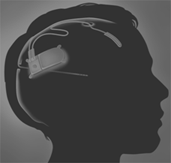|
From rxpgnews.com Epilepsy
Neurologists at the University of Virginia Health System are now testing two separate devices to treat epilepsy. Participants are being enrolled in a national, clinical trial of an implantable device called the RNS or Responsive Neurostimulator System, manufactured by Neuropace, Inc., of Sunnyvale, Calif. The RNS is a flat device about the size of a half-dollar. It is implanted just under the scalp and connected to insulated wires with small electrodes at the end. These leads are implanted in the patient's brain or on the brain surface near where seizures are believed to start. When a seizure is detected by the RNS, a brief, mild electrical shock is delivered to suppress it. "Until now, drugs have been the mainstay of therapy for people with epilepsy," said Dr. Nathan Fountain, a UVa neurologist and director of the F. E. Dreifuss Comprehensive Epilepsy Program. "The idea that we can implant a Star Trek-type device that will detect seizures and interrupt them without causing injury is entirely new. Many people with epilepsy have seizures that begin at one focal point in the brain, but they aren't appropriate for epilepsy surgery. If we show that responsive neurostimulation is safe and effective, then it has the potential to help many patients with epilepsy lead more normal lives." Usually, the activity in brain waves is intentionally uncoordinated. But during an epileptic seizure, brain waves from thousands of the brain's neurons start firing together. It's the opposite of what happens in a heart attack when the heart muscle beats wildly. "The idea behind the RNS is that a small electrical discharge, less than that of a battery across your thumb, will be enough to stop a seizure," Fountain said. UVa neurologists are also participating in a clinical trial of a deep brain stimulation (DBS) device manufactured by Medtronic, Inc. to treat epilepsy. DBS is currently being used to treat people with Parkinson's Disease. In DBS, surgeons implant a wire in a deep part of the brain that sends signals to the part of the brain-the thalmus-- that produces most epileptic seizures. "We are confident that DBS is safe for people with epilepsy since it is now being used on older people with Parkinson's. They do well with a low complication rate," Fountain said. These two devices-RNS and DBS- could offer new, potential treatment for patents with epilepsy without a lot of other treatment options, especially those whose seizures aren't controlled by drugs and who aren't good surgical candidates. Patients who have epileptic seizures after using one drug tend to continue to have them on another, Fountain said. As for what causes one person to get epilepsy and another not? Fountain and other neurologists say a specific cause remains a mystery. But they do know that people who have had brain tumors, brain trauma, a neurological infection or a genetic predisposition to epilepsy are more likely to be diagnosed with the condition. All rights reserved by www.rxpgnews.com |
